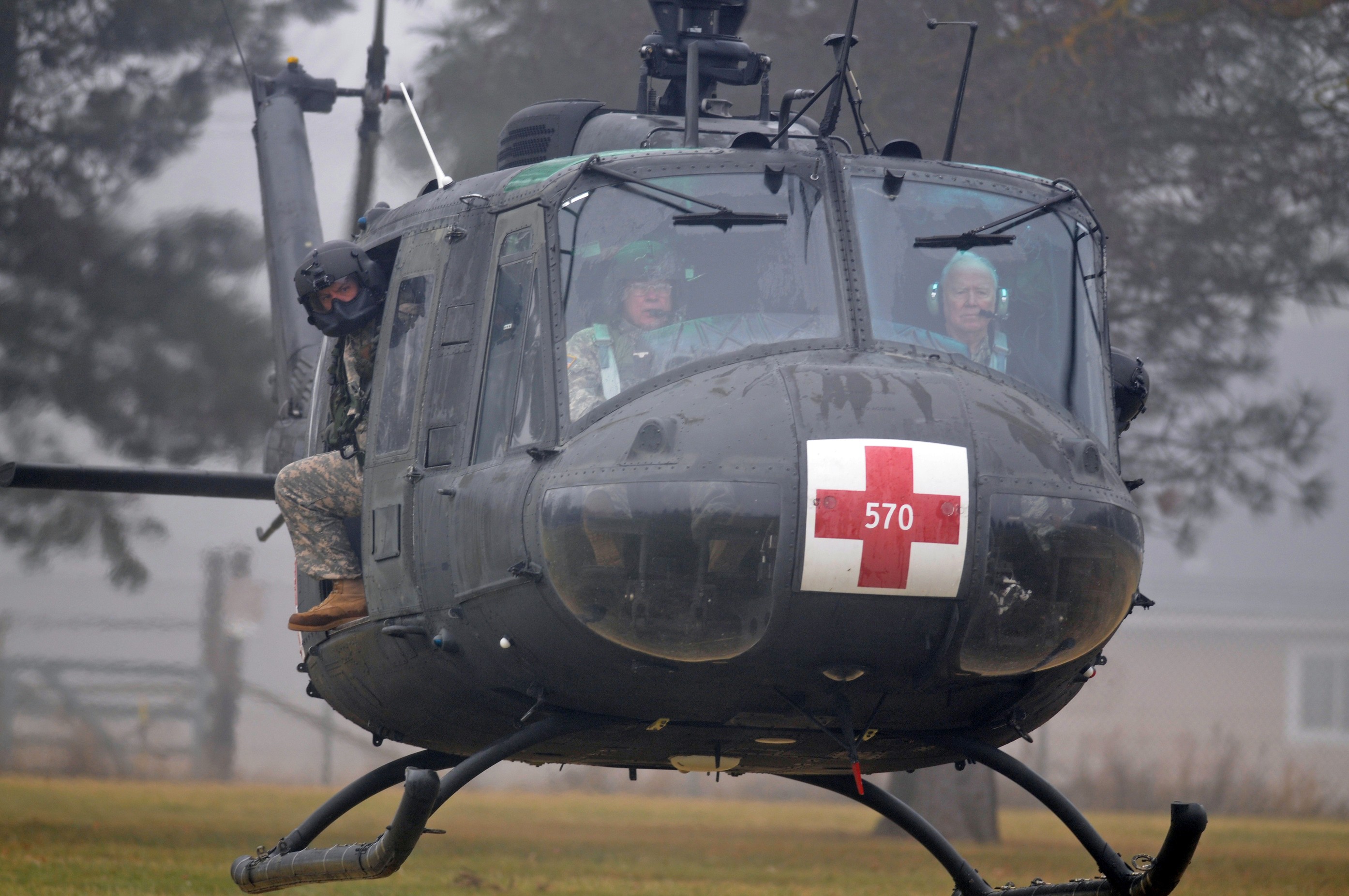
JOINT BASE LEWIS-McCHORD, Wash. (Feb. 4, 2011) -- Aircraft No. 570 awaited its final flight as a heavy morning fog shrouded the parade ground in a soupy mist.
It was under dark skies that Joint Base Lewis-McChord Yakima Training Center's U.S. Army Air Ambulance Detachment bid a fond and historic farewell to the last UH-1 "Huey" helicopter in its active-duty arsenal Jan. 26.
The symbolic final flight ushers in a new era for Army aviation.
USAAAD Commander Maj. George Johnson said the unit has tackled the transition with determination and professionalism.
"We started fielding the UH-72A 'Lakota' just this past year," Johnson said. "We started receiving them in September."
Unlike the Huey, the Lakota light utility helicopter is a dual-engine aircraft capable of speed up to 145 knots. In contrast, the Huey maxed out at 124 knots, he said.
The Lakota has an external hoist system and fully integrated computerized cockpit.
However, the UH-72 does not outclass the UH-1 across the board, he said.
"There's a slight reduction in patient load," Johnson said. "The Lakota litter load is two patients and the Huey could do three."
Because average evacuations require the transport of less than two patients, the smaller load capability should have no impact, he said.
"The mission hasn't changed at all," Johnson said.
USAAAD YTC will continue to fly medical evacuation and rescue mission throughout the Yakima area of operations, he said.
The venerable Huey entered service in the early 1960s and transformed Army mobility.
It was the UH-1 that helped pioneer the air assault concept.
With it's powerful turbine engine and considerable speed, the Huey could evacuate casualties from the battlefield rapidly.
"That speed, that mobility, saved many lives," Johnson said.
Now, very few "dust off" Hueys remain in the Army's inventory, he said.
"There are probably less than a dozen left in active-duty service," Johnson said.
More than 15,000 UH-1s were produced and nearly half that number flew in Vietnam, he said.
"The Huey's a great aircraft," Johnson said. "There's no mistaking it when you hear it coming over a ridgeline."
Saying goodbye to an Army icon was an emotional moment, he said.
"It's definitely a bittersweet moment," Johnson said.
The training center welcomed two distinguished guests for the ceremony. Retired Medal of Honor recipient Col. Bruce Crandall and Master Aviator Col. Phillip Courts were on hand to say farewell to an aircraft they knew well.
Courts, the event's guest speaker, played a key role in the original rollout of the UH-1 and has flown the Huey since 1961.
"I was the first flight commander of the Huey transition program," Courts said.
Courts' son, I Corps aviation officer Col. Michael Courts, had been slated to be the event's guest speaker, he said.
"He called me and asked if I would like to do it," Phillip said. "He said, 'you have more time in Hueys than I do.'"
From the earliest days of the aircraft's operation, the UH-1 became an indispensable part of the Army, he said.
"I spent three years with the 11th Air Assault when we developed air mobile techniques," Phillip said.
Those who flew it will miss the Huey, he said.
"I know there are bigger and better things out there now but it really served its purpose," the father said.
Some of Crandall's harrowing exploits were recreated in the movie "We Were Soldiers."
In the film, the thumping sound of the Huey's rotor blades became a beacon of hope to the troops locked in bloody conflict at LZ X-ray.
Crandall said it would be hard for another aircraft to unseat the Huey as an Army icon.
"The Huey was the best helicopter the Army had," Crandall said. "It lasted the longest."
If it weren't for the UH-1, many Soldiers would have died on the battlefield, he said.
"It saved an awful lot of people in Vietnam," Crandall said. "It's quite an aircraft."
One last lap Chief Warrant Officer 4 Joseph Long, 64, flew Hueys during the Vietnam War in 1970 and '71 with the 1st Aviation Brigade, starting preflight procedures on Aircraft 570. "I've been doing this a long time," Long said.
Called back to active duty a few years ago, he entered the Army in 1968.
Being the command pilot for the last YTC Huey flight is a great honor, he said.
"It's a historical moment for me personally to get to fly with Crandall and Courts," Long said.
Long has a lot of memories tied up in the UH-1, he said.
"I've been flying this aircraft for so long (today) it feels like getting rid of my first car," Long said.
All of the missions he flew in the Huey were different from one another, he said.
"It doesn't matter what you do," Long said. "If you have a good aircraft and a good crew, you can do anything."
Crew chief Spc. Micheal Hofhenke, 20, said he was overwhelmed by the significance of the final flight.
"It's amazing - especially being the youngest Soldier here," Hofhenke said. "It's definitely an honor."
Meeting and flying with Crandall and Courts left a big impact on him, he said.
The crowd watched as Long, Hofhenke, Courts, Crandall and Sgt. 1st Class Michael Schantz climbed into the aircraft.
With a high-pitched whine and a puff of black exhaust, 570's rotors began to turn.
The fog prevented the crew from flying the planned route that would have toured the YTC area. Still, Long lifted the helicopter into a hover and flew a short, low-altitude pass around the parade grounds.
Sitting left seat, Crandall took the controls and flew the UH-1 over the field.
When the aircraft finally touched down and the rotors ceased turning, Crandall and Courts emerged from 570 with huge smiles.
Rick Wood: rick.wood@nwguardian.com

Social Sharing